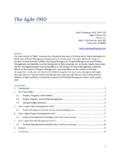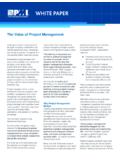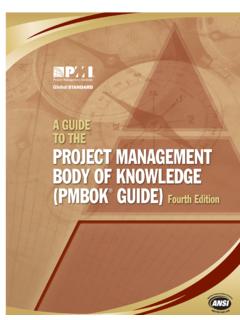Transcription of Guidelines for Preparing Performance Evaluation Reports for …
1 Guidelines for Preparing Performance Evaluation Reports for Public Sector Operations January 2006 Operations Evaluation Department Asian Development Bank ABBREVIATIONS ADB Asian Development Bank EIRR economic internal rate of return FIRR financial internal rate of return OED Operations Evaluation Department OEM operations Evaluation mission PCR project /program completion report PPER project Performance Evaluation report RRP report and recommendation of the President TA technical assistance CONTENTS Page I. GENERAL 1 A. Introduction 1 B. Borrower and Beneficiary Participation in Evaluation 2 C. Position Paper 2 D. Format and Finalization of Performance Evaluation Reports 3 E. Dissemination of Reports 3 II. CONTENT OF A project Performance Evaluation REPORT 4 A. Executive Summary 4 B.
2 Chapter I: Introduction 4 1. Evaluation Purpose and Process 4 2. Expected Results 4 C. Chapter II: Design and Implementation 5 1. Formulation 5 2. Rationale 5 3. Cost, Financing, and Executing Arrangements 5 4. Procurement, Construction, and Scheduling 5 5. Design Changes 6 6. Outputs 6 7. Consultants 6 8. Loan Covenants 6 9. Policy Framework 6 D. Chapter III: Performance Assessment 7 1. Overall Assessment 7 2. Relevance 9 3. Effectiveness 11 4. Efficiency 12 5. Sustainability 14 E. Chapter IV: Other Assessments 16 1. Impact 16 2. Asian Development Bank and Borrower Performance 18 3. Technical Assistance 19 F.
3 Chapter V: Issues, Lessons, and Follow-up Actions 19 1. Issues 19 2. Lessons 19 3. Follow-Up Actions 20 APPENDIXES 1. Sample Format for the Report Cover and Other Preliminary Pages 21 2. Sample Executive Summary 26 3. Examples of Rating Each Criterion and Overall Performance Assessment 28 4. Sample of an Economic Reevaluation 36 5. Treatment of Exchange Rate and Price Variations in the Analysis of Completed Projects 44 6. Sample of Follow-Up Actions 46 ADDENDUM 1: Evaluating Program Lending ADDENDUM 2: Contents of a Technical Assistance Performance Evaluation Report I. GENERAL A. Introduction 1. These Guidelines cover the preparation of Performance Evaluation Reports for Asian Development Bank (ADB) projects, programs , and technical assistance (TA) in the public They replace ADB s Guidelines for Preparation of project Performance Audit Reports (2000) and Guidelines for Preparation of Technical Assistance Performance Audit Reports (1992).
4 Adoption of these new Guidelines represents a further step in the process of harmonizing ADB s Performance Evaluation process with those of its major development 2. Compared with the 2000 Guidelines for project Performance audit Reports , the number of core criteria for rating a project s success have been reduced from five to four. Changes have also been made to the weights applied to the core Evaluation criteria for aggregation purposes and to the cutoff points used to assign an overall rating. In addition, the report structure has been revised. Finally, the term audit in report titles has been changed to Evaluation to reflect the process more accurately. Revisions have also been made to the 1992 Guidelines for TA Performance audit Reports and new Guidelines have been prepared for evaluating program loans. 3. Evaluation is an important part of ADB s project cycle.
5 Evaluation has two major dimensions: (i) self- Evaluation by the operations departments responsible for Preparing and implementing projects, programs , and TA operations; and (ii) independent Evaluation by the Operations Evaluation Department (OED). Self- Evaluation entails the use of a number of instruments, including (i) project /program Performance Reports ; (ii) review Reports prepared during the course of project implementation, typically at midterm; (iii) project /program completion Reports (PCRs); (iv) TA completion Reports ; and (v) country portfolio Performance reviews. With the exception of project preparation TA resulting in a loan, ADB policy is to conduct PCRs and TA completion Reports on all completed projects, programs , and TA. Such Reports can be viewed at 4. The basic instruments for independent evaluations of projects and programs are the project Performance Evaluation report (PPER) and the program Performance Evaluation report, respectively, prepared by OED.
6 These evaluations contribute to other OED studies, including country and sector evaluations and special Evaluation studies, which focus on particular issues or subjects of broader relevance to ADB s operations, policies, and procedures. Broader evaluations are becoming an increasingly important part of OED s work. OED also carries out independent evaluations of TA, typically following a cluster approach or evaluating TAs provided in conjunction with a loan in the corresponding project or program Performance Evaluation report. To be useful, evaluations must be forward looking ( , identifying issues, lessons, and recommendations that will be useful for future operations) in addition to assessing past Performance . 1 Separate Guidelines are available for Performance Evaluation of ADB private sector operations. 2 Good practice standards for evaluating public sector operations agreed to by the Evaluation Cooperation Group of the multilateral development banks have been incorporated into the revised Guidelines .
7 2 5. The basis for successful Evaluation work is established at the project , program, or TA design stage with the preparation of the design and monitoring Along with key Performance assumptions, this specifies a hierarchy of objectives, the indicators of success with their targets, and the methods for measuring the indicators. Key elements of the design and monitoring framework form the basis of the project , program, or TA Performance report and the other Performance monitoring Reports produced during project implementation as part of ADB s project Performance management system. The Performance management system, primarily through the project and program Performance Reports and PCRs, provides information needed for self-assessments and for OED s subsequent Performance Evaluation . Understanding the political economy in which the project or program is operating is fundamental to assessing the long term sustainability, effectiveness, and efficiency of the project /program.
8 6. OED s target is to postevaluate 25% of completed projects for which PCRs are available and that have at least 3 years of operational The PPER focuses on achievements and their sustainability; on an overall assessment of the project s Performance ; and on issues, lessons, and follow-up recommendations. OED helps operations departments prepare about half of all PCRs with the objective being to ensure the maintenance of satisfactory self- Evaluation Prior to 2004, OED carried out Performance evaluations of all completed program loans. Since then, program evaluations have been conducted selectively, particularly in sectors or areas where they have not been produced before or as required as inputs for other evaluations. In accordance with ADB s public communications policy, a Performance Evaluation schedule for the coming year, together with the selection criteria to be used, is published each December. B. Borrower and Beneficiary Participation in Evaluation 7.
9 project ownership by borrowers and beneficiaries is necessary to ensure project quality. Accordingly, by means of participatory processes, ADB seeks the views of borrowers, executing agencies, and beneficiaries when assessing the success or otherwise of projects and programs . Most loan documents require that the borrower and/or executing agency prepare a completion report for submission to ADB, and this document is reviewed during Performance Evaluation . C. Position Paper 8. The leader of the operations Evaluation mission (OEM) prepares a position paper at an early stage of the Performance Evaluation process for approval by the director general, OED. This highlights the approach of and major issues to be addressed by the Evaluation . It will typically include information about (i) the way in which the borrower and beneficiaries will be involved; (ii) the need for any studies; (iii) the subcriteria to be used in the ranking process; (iv) a re-statement, if required,6 of the impact and outcome statements in the design and monitoring 3 In 2005, ADB changed the term project framework, used in previous Guidelines , to design and monitoring framework.
10 The terminology used in framework summaries has also changed, with goal becoming impact and purpose becoming outcome. 4 Selection is based on a random sample stratified by sector and modified by the following factors: (i) rating proportions of completion Reports , (ii) accumulated sector coverage, (iii) upcoming country and sector assistance program evaluations and special Evaluation studies, and (iv) accumulated country coverage. 5 OED is considering the use of an abbreviated PPER for projects that are selected for Performance Evaluation during its sampling process and for which in-depth assistance has already been provided at the PCR stage. 6 This might be the case if the OEM considers that the objectives were unrealistic or if confusion between outputs and outcome is apparent in the design and monitoring framework. The intent is to reconcile sometimes contradictory statements and/or there is a need to read between the lines to determine what the expected outcome was.














